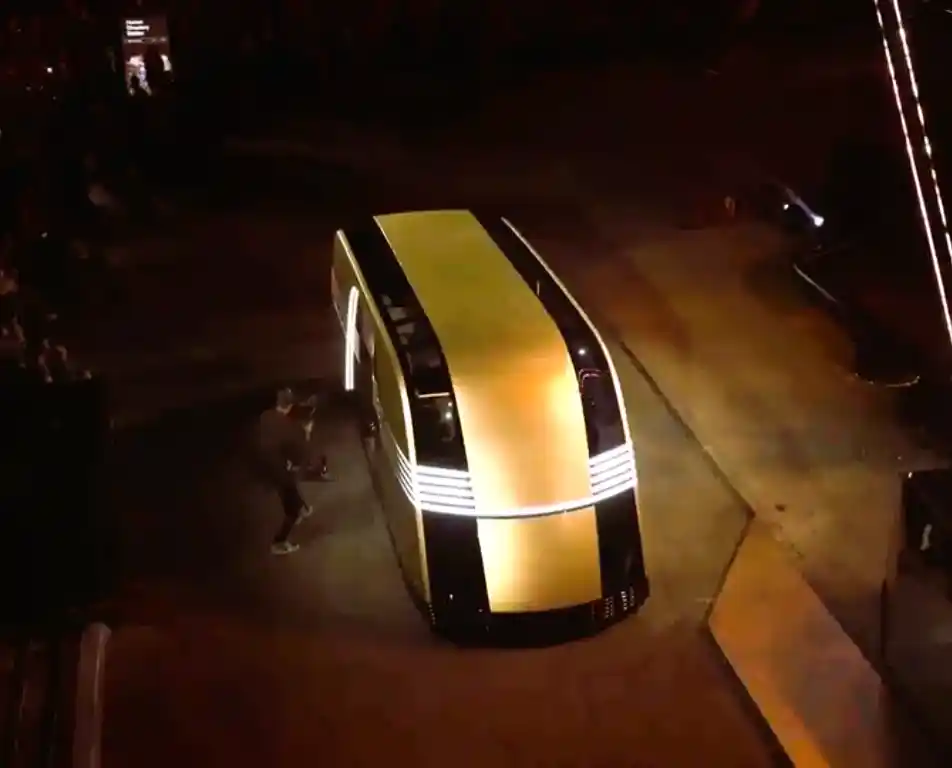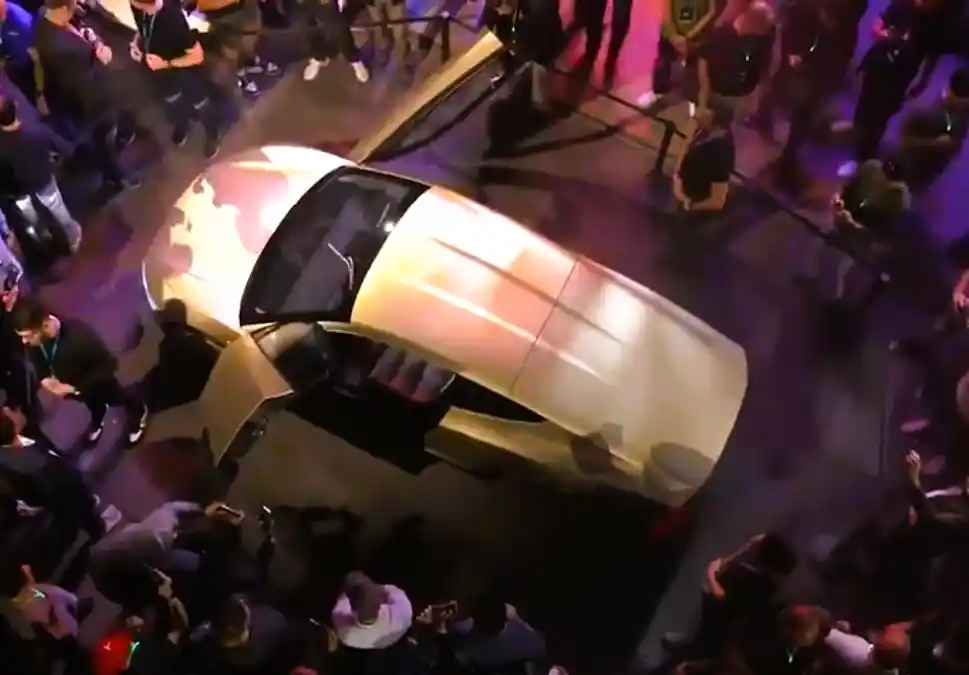
Tesla CEO Elon Musk recently unveiled the long-awaited “Cybercab” robotaxi during an event held at Warner Bros Studios in Burbank, California. The vehicle, designed without pedals or a steering wheel, made its first public appearance by delivering Musk directly to the stage.
The crowd eagerly awaited more information on a project that Musk believes is pivotal to the future of Tesla.
The sleek, futuristic design of the Cybercab with its two wing-like doors signals a new era for autonomous vehicles. At the event, titled “We, Robot,” Musk reiterated his firm belief that fully autonomous vehicles will be much safer than human-driven cars.
He also expressed optimism about the financial opportunities these robotaxis could offer, hinting that owners might be able to rent them out for rides, creating a new income stream.
Despite the buzz surrounding the announcement, the financial markets responded less enthusiastically. Tesla’s share price dipped notably after the markets opened in the U.S. on Friday, dropping over 8%, with shares trading at approximately $219 by midday Eastern Time.
In contrast, shares of Uber and Lyft, which are also working on their own autonomous vehicle projects, saw gains of up to 10%.
Skepticism Over Production Timelines and Pricing
Musk’s announcement that the Cybercab could be in production “before 2027” was met with some skepticism, given his track record of overpromising and underdelivering on deadlines. “I tend to be optimistic with time frames,” Musk acknowledged humorously during the event.
He also made a bold statement that the Cybercab could retail for under $30,000, positioning it competitively against rivals like Alphabet’s Waymo.
However, industry analysts have expressed doubts about whether this price point is realistic. Paul Miller, a researcher at Forrester, commented, “It will be extremely difficult for Tesla to offer a new vehicle at that price within that timeframe.”
He added that without significant subsidies or Tesla accepting losses on each unit sold, achieving such a price point by the end of the decade seems unlikely.

Regulatory and Safety Concerns Loom Large
Musk also took the opportunity to discuss his vision for Tesla’s broader self-driving technology, hinting that “fully autonomous, unsupervised” driving could become available for Tesla’s Model 3 and Model Y vehicles in states like Texas and California by next year, pending regulatory approval.
However, this is far from guaranteed, as regulators have significant safety concerns when it comes to self-driving technology.
Samitha Samaranayake, an associate professor of engineering at Cornell University, raised concerns about the risks involved with fully autonomous vehicles. “It’s a large, fast-moving object on public roads, so safety is a major concern,” she noted.
Tesla’s approach to self-driving technology relies heavily on cameras, which are more affordable than radar or Lidar sensors used by many of its competitors. However, this cost-saving measure has drawn criticism.
Samaranayake added that the research community remains skeptical about whether Tesla’s AI-powered system can offer the level of safety needed for wide-scale deployment.
Tesla Playing Catch-Up in the Robotaxi Market
Tesla’s Cybercab project has faced repeated delays, initially expected to be unveiled in August of this year. According to Musk, the delay was necessary to incorporate design changes he deemed important.
The long-awaited debut comes as Tesla faces stiff competition from other autonomous vehicle developers, many of which already have robotaxis on U.S. roads.
For example, Waymo, a division of Alphabet, has been actively testing autonomous vehicles and announced plans in early October to add the Hyundai Ioniq 5 to its fleet. Uber is also pushing forward with its autonomous ambitions, announcing a multi-year partnership with driverless car company Cruise in August to expand its ridesharing and delivery services.
Meanwhile, Chinese tech giant Baidu is reportedly considering expanding its robotaxi division, Apollo Go, beyond China, where its autonomous vehicles are already operational in several cities.
Tesla Faces Market Challenges Beyond Robotaxis
While Musk continues to paint an optimistic picture of the future with autonomous vehicles, Tesla’s broader electric vehicle (EV) market share is under pressure.
The company is projected to report its first-ever decline in annual sales as competitors flood the EV space. Despite growing market competition, Tesla’s sales have slowed, and the company seems to be facing increasing challenges in maintaining its dominance.
Despite these hurdles, Musk didn’t shy away from offering a spectacle during Tuesday’s event. The event featured Tesla’s humanoid robots entertaining the audience by dancing and even serving drinks, adding a layer of futuristic showmanship to the presentation.
In addition to the Cybercab, Musk also unveiled a prototype of the “Robovan,” which is designed to transport up to 20 passengers at a time. This vehicle, Musk explained, could become another important part of Tesla’s transportation portfolio in the coming years.

Looking Toward the Future of Autonomous Driving
Jessica Caldwell, the head of insights at Edmunds, offered some praise for Musk’s presentation, saying that he “did a fantastic job of painting an ideal future for transportation that promises to both free up our time and increase safety.”
However, she tempered her praise with some skepticism, noting that there are still many unanswered questions about how Musk’s vision will be realized in practice.
Indeed, while the Cybercab’s design and price point may have garnered attention, the feasibility of Tesla’s plans remains uncertain. Can Tesla develop a robotaxi that is both affordable and safe by 2027?
Will regulatory approval for fully autonomous vehicles come in time to meet Musk’s optimistic timelines? These are critical questions that will need to be answered in the years to come.
The Broader Robotaxi Market
The robotaxi market continues to evolve, although it faces its own challenges. Cruise, General Motors’ autonomous vehicle subsidiary, recently suspended its driverless car operations in San Francisco after a pedestrian was struck. Such setbacks underscore the complexity of deploying fully autonomous vehicles on public roads, even as technology continues to improve.
Despite these obstacles, the demand for autonomous vehicles is growing, with companies like Waymo, Uber, and Baidu all pushing forward with their robotaxi programs.
As these companies continue to expand their fleets, the future of transportation seems poised to shift dramatically, though questions about profitability and safety remain.
In summary, while Tesla’s Cybercab announcement is a bold step toward the future of autonomous driving, significant challenges remain. From regulatory hurdles to financial concerns, the road ahead for Tesla—and the broader robotaxi market—appears uncertain but full of potential.





